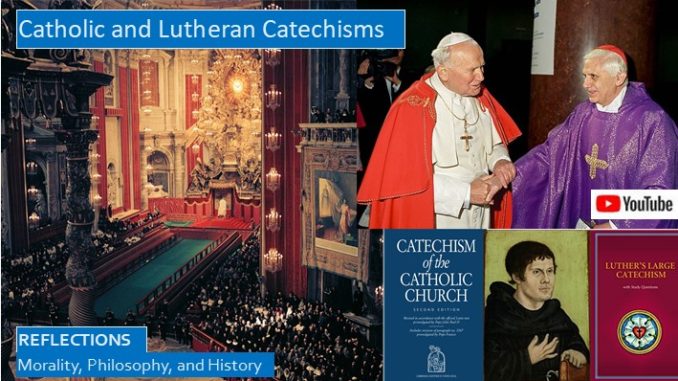
Who should study the Catechism? Everyone! Everyone who is Catholic? No, everyone who wants to live a godly life should study the Catechism. The Catechism was reviewed by thousands of bishops before publication, many thousands of suggestions were pondered, more thought and care was invested in the editing of the Catholic Catechism than probably any modern book in print. You ignore this wisdom at your moral peril. These teachings are not merely preachings, they are annotated by thousands of footnotes to both Scripture verses and the writings of the Church Fathers and the decrees of Vatican II, Trent, and the other councils, so you can go back to the sources yourself.
Read Catechism of the Catholic Church OnLine
The YouTube video for this blog has additional history of rising literacy in Christendom and the Lutheran Catechism, and how its organization was adopted by the Catholic Catechisms of Trent and Vatican II: https://youtu.be/i8WXS7l4OzE
Through the sacrament of penance priests often have to advise their flock on how to deal with the problems we confront in our lives that are often caused by the poor choices made by ourselves or our loved ones. Consequently, the Catechism provides a framework to address the problems of the family, including marriage, children, and divorce, and other dilemmas many of us face, such as abortion, suicide, drug abuse, alcoholism, and homosexuality. If you are not Catholic and do not agree with the Catholic Church’s teachings these sections are useful because they tell you why the Church teachings are what they are, so you are better able to chart your course through our life’s troubled waters.
Cardinal Ratzinger, who would later become Pope Benedict, in an in-depth interview in 1985 that the spirit of Vatican II had faded, that it failed to generate a new enthusiasm, but instead Catholicism had become trapped in a spirit of “boredom and discouragement.” What the opponents and supporters of Vatican II shared in common is neither understood nor studied the actual decrees of Vatican II. He compared the post-Vatican II Church to a “construction site where the blueprint had been lost but everyone continues to build according to his taste.”[1]
Ratzinger and Pope John Paul II felt that this ignorance was a failure in catechesis, that the Church needed to develop a new catechism to make those in the Church more aware of the Catholic and Christian message, the Good News, the Gospel. Which means the Catechism is not only evangelical, it is the best type of evangelism. How did the early Church evangelize? Did they promote their music ministries? Did they hire marketing managers, coining phrases like Faith is Fun? Did they seek to entertain their parishioners? To answer this, we need only read the words of St Paul, who proclaimed the Gospel “first to those in Damascus, then to those in Jerusalem and in all Judea, and then to the Gentiles, I preached that they should repent and turn to God and demonstrate their repentance by their deeds.”[2]
You can also purchase and/or view the full Catechism on-line at the US Catholic Bishops website:
http://www.usccb.org/beliefs-and-teachings/what-we-believe/catechism/catechism-of-the-catholic-church/
IS THE CATECHISM MERELY A CATALOGUE OF FORBIDDEN SINS?
Cardinal Ratzinger, responding to criticisms that the new Catholic Catechism that it was mainly a catalogue of sins, said that the “Church mainly wanted to tell people what they could not do that she had a fixation on sin.” This criticism tells us more about ourselves that it tells us about Catholicism, this criticism tells us that we prefer a spirituality where we live by our own rules, not rules provided by a centralized Church nor an omniscient Deity nor a Bible written millennia ago, we would rather, as the Book of Judges tell us, do what is right in our own eyes.[3]
Answering this criticism, Cardinal Ratzinger observes, “JP Sartre regarded it as man’s basic drama, indeed, tragedy, that he is thrown into a freedom that leaves him to determine what he ought to do with his existence. But this is precisely what man is ignorant of, and every time he plunges into an adventure of uncertain outcome.” As an example, one of our first youthful choices is whom we should marry, and how many parents become horribly frustrated as they plead and beg their children to consider how momentous and life-changing this choice often is. We want to be free to choose, but we do not want to ponder our choices until after we have made them. Thank God for the sacrament of penance!
What is the core of the faith and the Catechism? “You shall Love the Lord your God with all your heart, and with all our soul, and with all your mind, and you shall love your neighbor as yourself. On these commandments have all the Law and the prophets.” (CCC 2055)
How does Cardinal Ratzinger restate this? “The Catechism’s fundamental anthropological proposition is that man is created in God’s image and is thus like God.” God demands that man obey his moral commands to live a godly life because man has been created in God’s image. “This truth grounds those rights that are inherent in man from conception to the final moment of his existence. No one has to give man these rights, no one can take them from him: he has them of himself. It follows that the image of God is also the basis of human dignity, which in every man is inviolable simply because he is man. Finally, man’s Godlikeness also implies the unity and equality of men. As creatures of the one God, all men are of the same rank, are related to one another as brothers, are responsible for one another and are called to love their neighbor, no matter who he may be.”
What Cardinal Ratzinger is trying to tell us is that morality, Loving God, loving our neighbor as ourselves, are all about obedience to God, obeying the commandment, but the roots from love will grow much deeper in our soul, they are so much more, this Holy Love becomes part of our essence, part of our soul, part of our very being, flowering into our dignity as men created in the very image of God, loved by God, cherished by God, granting us the grace to truly Love God and love our neighbor as ourselves.
We seek love, we seek connectedness, we seek happiness. “As he pursued the tangled paths of his life, Augustine constantly asked himself one question: How can I attain happiness?”
The Catechism teaches us that happiness comes from our fellowship and concern and care for our fellow man and from our communion with God. “Morality is a doctrine of happiness and the means to attain it, not an egoistic pseudo-happiness but real happiness.”
Together “with the Bible and the faith of the Church, the Catechism affirms that man’s happiness is love. The morality of the Catechism is a teaching about the nature of love.” We can see this true love “visibly in the Person of Jesus Christ, in His Words, and in His life and death. The Ten Commandments merely unfold the ways of love, we understand the Decalogue correctly only when we read it together with Jesus Christ.” “Moral doctrine takes as its starting point the yearning for happiness and love that the Creator has placed in each of our hearts.”[4]
FORMATION OF THE CATHOLIC CATECHISM
Twenty years after the close of Vatican II an extraordinary synod of bishops was convened to explore the future path of the Church. The synod felt that the Church was drifting, that there was an “emptying out of catechesis,” that catechetical instruction was often ineffective. This synod established a commission to draft a new Catholic Catechism, starting a process that would last six years.
The Synod desired that the Catechism “should be written, not by scholars, but by pastors drawing on their experience of the Church and the world.” The Catechism would use the outline of the Trent Catechism, drafts of the section on the Creed would be written by bishops from Spain and Italy, drafts on section on the sacraments would be written by bishops from Chile and Argentina, and the section on morality would be written by bishops from France and England. The synod desired that the section on prayer be written by a representative of Eastern theology, a Lebanese bishop, who wrote his section in his basement while Beirut was being bombarded. The commission under the direction of Cardinal Ratzinger, who would later become Pope Benedict. The editor of the Catechism was Christoph Schonborn, who had earned his doctorate of theology under the instruction of Professor Ratzinger. These drafts were submitted to all the bishops, who suggested over 20,000 modifications that were considered, making the Catechism truly a collegial effort of the Catholic Church.[5] Cardinal Ratzinger tells us, “We took care to maintain a balance between witnesses from East and West in order to underline the truly catholic character of the Catechism. We also tried to take due account of the words of holy women.”[6]
For whom was the Catholic Catechism composed? Schonborn says that it was composed first and foremost for the bishops who are primarily responsible for promoting unity in the Church, and through the bishops, the priests. But the Catechism was not written for just a select few, the Church desired that interest laymen should have access to the teachings of Church, so they “can know for themselves what the Church teaches and she does not,” so their faith can mature, so they can take greater responsibility for their faith. Finally, “the Catechism should serve the original task of catechesis, evangelization.” The Catechism is also composed to present the Catholic teaching to the entire world, to “agnostic, seekers and inquirers, so they can become acquainted with what the Church teaches and tries to live.”[7]
TIPS TO STUDY THE CATECHISM
In addition to the Catechism you should also purchase the Companion to the Catechism, which includes both the many Bible verses footnoted in the Catechism, but also the excerpts of the other writings referenced in the footnotes, some of which are difficult to find otherwise. I purchased a used copy and it was brand new, there must be boxes of this book in warehouses somewhere.
The only difference between the larger US Catholic Bishops version of the Catholic Catechism and the smaller version you can find in the bookstores is the appendices, but the appendices are what make an in-depth study of the Catechism and both the Eastern and Western Church Fathers possible.
There is an index of the abbreviations used in the footnotes on page 861. The DS abbreviation refers to Denzinger, the compilation of historically important documents. Most, but not all, of these documents reflect the current teaching of the Church, but all are important in the history of the Church.
Often you will see the PG and PL abbreviations, these refer to the compilation of the writings of the Greek and Latin Church Fathers. English translations of these works are found in the Ante-Nicene and Nicene Church Fathers series, although the Cappadocian Church Fathers are underrepresented. These works are usually cited by their Latin titles, Dr Google can help you translate them so you can find the English titles in the Church Fathers series. Although you can purchase the bound copies of this two library shelf collection for a reasonable price, you can also purchase a DVD with all these works for under ten dollars (see link).
There is also an index of Citations of Bible verses, Ecumenical Councils, Papal Decrees, canon law, liturgies, and also Ecclesiastical Writings by all the Church Fathers. This enables you to see where works like St Augustine’s Confessions are referenced in the Catechism.
If you are interested in embarking on a study course of the Church Fathers, one approach is to read their works as they are cited in the Catechism. With this plan of study you will eventually read most, though not all, of the important patristic writings.
[1] Cardinal Ratzinger, “The Ratzinger Report,” (San Francisco: Ignatius Press, 1994), pp. 29-42.
[2] https://www.biblegateway.com/passage/?search=acts+26%3A20&version=NIV
[3] Joseph Cardinal Ratzinger, “Gospel, Catechesis, Catechism, Sidelights on the Catechism of the Catholic Church,” (San Francisco: Ignatius Press, 1994), pp. 12-13.
[4] Joseph Cardinal Ratzinger, “Gospel, Catechesis, Catechism,” pp. 14-17.
[5] Joseph Cardinal Ratzinger, “Introduction to the Catechism of the Catholic Church,” (San Francisco: Ignatius Press, 1994), pp. 11-26.
[6] Joseph Cardinal Ratzinger, “Gospel, Catechesis, Catechism,” p. 20.
[7] Joseph Cardinal Ratzinger, “Introduction to the Catechism of the Catholic Church,” pp. 17-19.

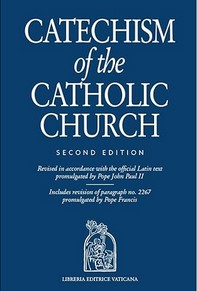
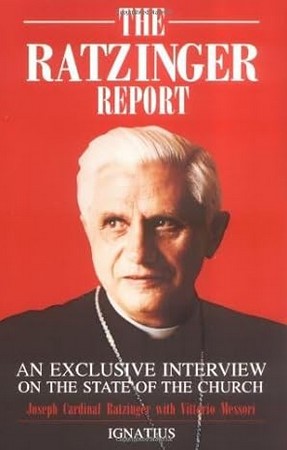
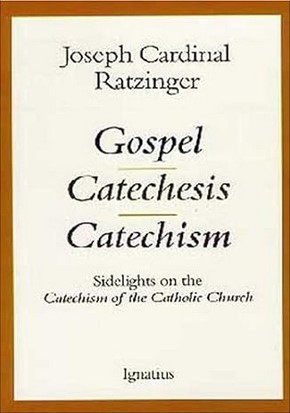
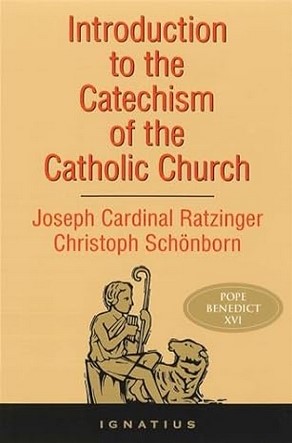
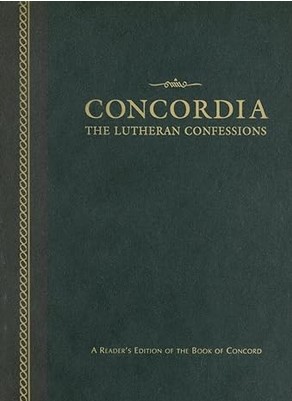
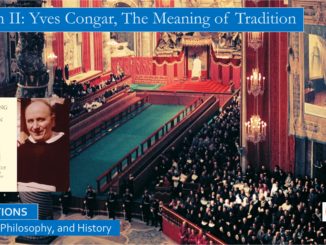
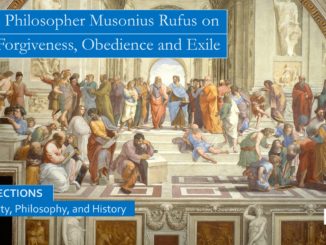
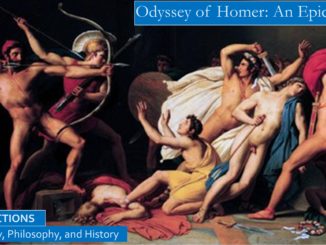
3 Trackbacks / Pingbacks